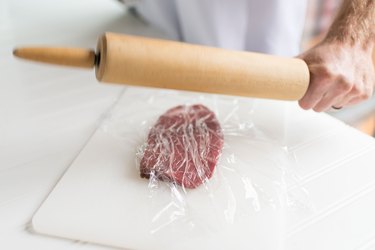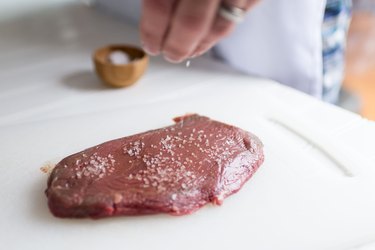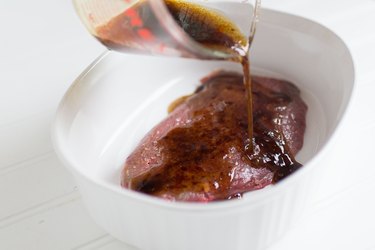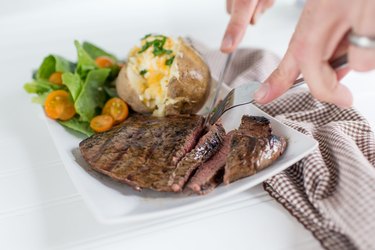Sirloin steaks occupy an uncertain place in the steak lover's pantheon. They're typically more flavorful than most premium grilling cuts, but vary wildly in tenderness. Even top sirloin, the tenderest of the sirloin cuts, can range from meltingly delicate to leather-like from steer to steer. Steak lovers can draw on a number of well-established techniques to tenderize these tasty sirloins, and the best results usually come from combining two or more of them.
Step 1: Pound It
What to Do: Pound your steak over its entire surface with a meat mallet, a plastic-wrapped rolling pin or similar blunt object. Alternatively, use a fork or the tip of a paring knife to perforate it liberally on both sides, severing the tight muscle fibers.
Video of the Day
Why: Sirloin steaks are tougher than most grilling steaks because they flex repeatedly as the animal stands or moves around, making them denser and chewier. Pounding your sirloin steak with a meat mallet, or something similar, tenderizes it by physically tearing the bonds that hold the muscle fibers together. Spiked tenderizers, called jackard tenderizers, shear the bonds like a miniature knife. Plus, pounding or perforating the steak opens up the interior of the beef, enhancing a marinade's mild tenderizing effect and enabling flavors to penetrate more deeply.
Step 2: Salt It
What to Do: Sprinkle the steak liberally with coarse sea salt or kosher salt. Don't use table salt, which contains iodine and can give your steak a harsh chemical flavor. Rest the steak for at least an hour, then rinse off any excess salt and blot them dry with fresh paper towels.
Why: Cured meats are typically tenderer than the cuts they're taken from because of the high salt content. Brining a steak can make it watery, but salting it at least an hour ahead of time is an effective alternative. This technique, sometimes called dry-brining, leaves time for the salt to dissolve and be absorbed into the muscle. Aside from its tenderizing effect, it gives you a savory, perfectly seasoned steak.
Step 3: Let It Soak
What to Do: Put your steak in a food-safe container and pour your favorite marinade over it. Turn the steak to expose both sides to the marinade, then let it rest for an hour or longer. Remove your steak from its marinade and blot the surface dry with clean paper towels. Plenty of marinade will remain in the beef's microscopic crevices, so you won't lose out on flavor.
Why: Acidic marinades are touted for their tenderizing prowess in most cookbooks. But while it's true that acids have the effect of breaking down proteins' molecular bonds, but there are two significant drawbacks to this technique. One is that if left too long, the acids will cause the proteins to contract and become tougher than they were in the first place. Second, the effect only takes place at the meat's surface. There's a lot of steak below the surface that won't be affected.
Step 4: Use Enzymes
What to Do: Sprinkle the steak lightly on both sides with enzyme-based tenderizer, if desired. The enzymes do almost all of their work during cooking, so there's no need to rest the steaks longer than the minute or so it takes for the powder to dissolve. Some meat tenderizers include salt, so go easy on the salt in your marinade if you plan on using a salty tenderizer on top of it.
Why: Many tropical fruits, including kiwis, papayas and pineapples, contain enzymes that tenderize meat. Powdered meat tenderizers strip away the fruit flavors, using just the purified enzymes -- papain, from papayas, or bromelain, from pineapples -- to tenderize your meat. They're very effective, but as with acidic marinades, they only work on the surface of the meat. If you use too much, enzyme tenderizers can give your steaks a mushy texture.
Step 5: Grill It Up
What to Do: Grill the sirloin using your favorite method until done to your liking. Slicing the steak thinly, once it's on your plate, is one final way to improve its tenderness.
Why: Thin-slicing shortens the tough muscle fibers, just as it does with flank steak and other tough cuts, making the steak easier to chew and enjoy.
Video of the Day
Tips
• The longer you cook your steak, the more its muscle fibers will contract and toughen. Avoid taking it further than medium-rare.
• High temperatures can also cause your steak to toughen. Once you've got a perfectly seared exterior, it's often helpful to finish cooking your steak on a cooler portion of the grill.
• It isn't necessary to use all these techniques, though each step helps. For example, you might opt to use only a marinade or enzyme tenderizer, rather than both.





